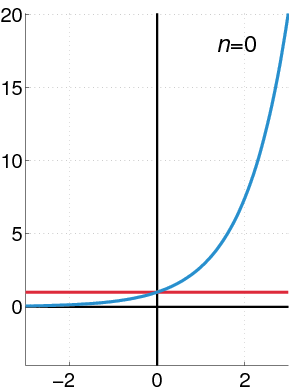The power series method is used to seek a power series solution to certain differential equations. In general, such a solution assumes a power series with unknown coefficients, then substitutes that solution into the differential equation to find a recurrence relation for the coefficients.

Maclaurin Power Series of an Exponential Function
The exponential function (in blue), and the sum of the first
Method
Consider the second-order linear differential equation:
Suppose
Suppose further that
After substituting the power series form, recurrence relations for
Example
Let us look at the case know as Hermit differential equation:
We can try to construct a series solution:
substituting these in the differential equation:
making a shift on the first sum:
If this series is a solution, then all these coefficients must be zero, so:
We can rearrange this to get a recurrence relation for
Now, we have:
and all coefficients with larger indices can be similarly obtained using the recurrence relation. The series solution is: